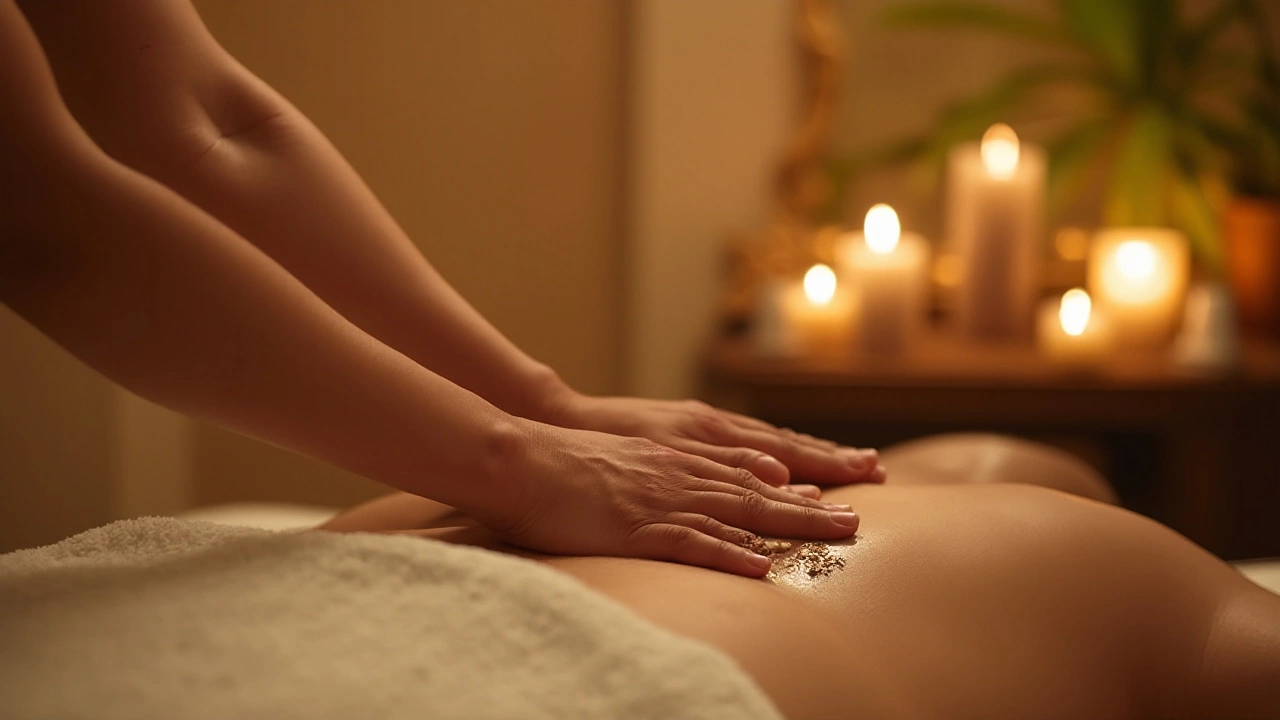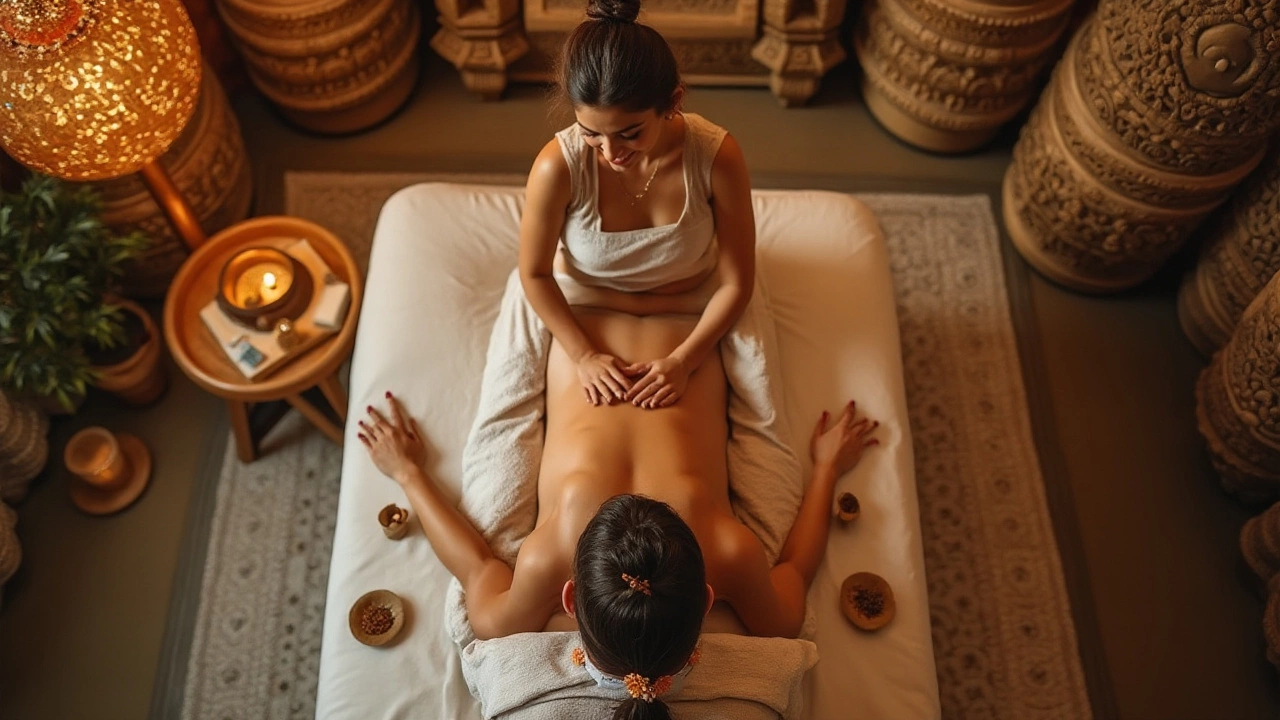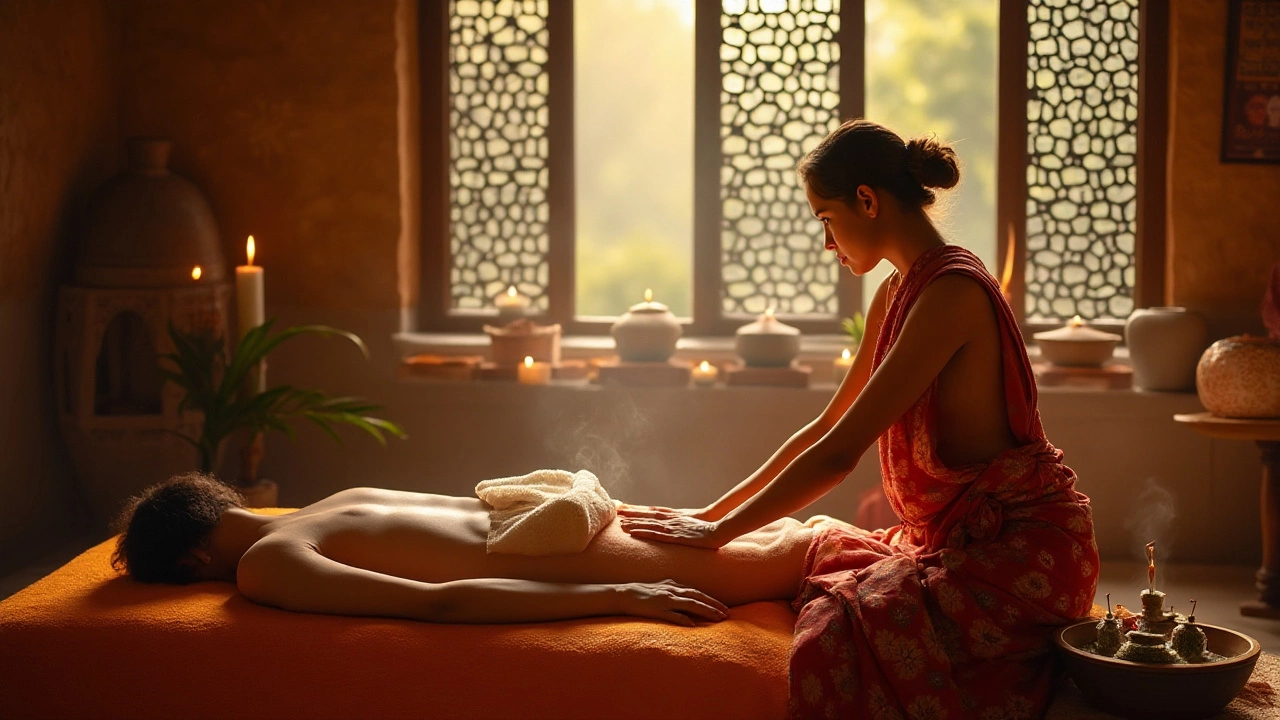At the heart of Ayurvedic massage lies a compelling blend of art and science. This traditional healing practice hails from the rich tapestry of Indian Ayurveda, a system of medicine that has been cherished for thousands of years. It's an approach that sees the body as more than just flesh and bones, understanding it instead as a holistic entity where balance is paramount.
The distinctive methods used in Ayurvedic massage are not just about pampering the body; they are a gateway to aligning mind, body, and spirit. Herbal oils infused with natural essences are often employed, each selected according to the dosha or body type of the individual, making each session a personalized journey toward health and serenity.
- The Foundations of Ayurvedic Massage
- Techniques and Methods
- Benefits for Body and Mind
- How to Prepare for an Ayurvedic Massage
- Choosing the Right Practitioner
The Foundations of Ayurvedic Massage
Ayurvedic massage finds its roots deep in the vast and colorful heritage of Indian traditions, representing a profound connection between the ancient world and the contemporary wellness movement. It is not merely a technique; it's a philosophy that embraces the simplicity and wisdom of nature. At its core lies the principle of doshas—Vata, Pitta, and Kapha—which are bio-energetic forces that govern physiological activity in the body. These doshas determine the individual constitution and affect both physical and mental health, creating a unique blueprint for wellness.
Each Ayurvedic massage is specially curated to harmonize these doshas, using oils specifically chosen to balance the body's energies. These oils, often blended with herbs, not only nourish the skin but also act as a medium to transfer the harmonious properties of the herbs into the body. Massages often involve rhythmic strokes intended to enhance circulation, stimulate lymphatic drainage, and facilitate the release of tension and stress.
As the legendary Ayurvedic scholar Charaka once noted, "When balance is disturbed, there is disorder, but when balance is restored, the joy of wholeness is possible."
The meticulous attention to individuality is what sets Ayurvedic massage apart from Western styles. While modern massages might focus primarily on muscle relaxation, Ayurvedic techniques delve deeper, aiming to cleanse the body from the inside out. This holistic view doesn't only address the body but also taps into the subtle energy that fuels life, known as 'prana.' It's this energy that practitioners believe links the subtle body with the physical form. An engaging element of this type of massage is the synchronization between the therapist's movements and the client's breath, which heightens the effect of Ayurvedic massage by paving the way for profound relaxation.
In Ayurveda, practitioners are often seen as guides or facilitators, channeling ancient wisdom rather than imposing a treatment. This approach fosters a therapeutic partnership between the practitioner and the recipient. The process usually begins with a consultation, where practitioners determine the dominant dosha and assess any imbalance. This initial insight is pivotal to tailor a massage sequence that aligns with the client's current health condition and lifestyle, ensuring maximum effectiveness.
An interesting aspect to note is how Indian traditions regard these practices not merely as a system of healthcare but as a way of life. The approach instills a sense of mindfulness, urging individuals to listen to their bodies more deeply. Current studies, although still developing, hint at the physiological benefits of Ayurvedic practices. A growing body of anecdotal evidence supports its effectiveness in stress reduction, detoxification, and even improving the immune response.
Here is a breakdown of typical Ayurvedic massage oils and their associated doshas:
| Oil | Dosha | Properties |
|---|---|---|
| Sesame | Vata | Warming, nourishing, grounding |
| Coconut | Pitta | Cooling, soothing, calming |
| Almond | Kapha | Light, invigorating, warming |
Techniques and Methods
An Ayurvedic massage experience is unlike any other, emphasizing the harmony between mind and body through both technique and touch. Drawing from ancient traditions, Ayurvedic massage utilizes specific methods curated over centuries. At its core, this practice seeks to balance the three doshas—Vata, Pitta, and Kapha—by employing techniques and oils tailored to an individual’s unique constitution.
The distinctive strokes and movements in Ayurvedic massage are deliberately slow yet firm, ensuring deep relaxation and maximum absorption of herbal oils. Abhyanga, one of the most prominent techniques, is a synchronized full-body massage performed by two therapists working in harmony. This technique incorporates rhythmic and repetitive strokes that help soothe the nervous system and encourage lymphatic drainage. It is particularly revered for its ability to balance Vata dosha by imparting warmth and grounding sensations, which is essential in revitalizing the energy pathways of the body.
Marma therapy also plays a vital role in Ayurvedic practices. It focuses on stimulating the 107 marma points found within the body. These points correspond to the juncture of muscles, veins, ligaments, and bones—key spots where vital life force or 'prana' can be either blocked or activated. The gentle pressure applied during this therapy enhances circulation, boosts immunity, and releases blocked energy, bringing a steady and harmonious flow of prana throughout the body.
An interesting fact about Ayurvedic massage is its reliance on custom-blended oils, often dosha-specific, to complement the techniques applied. For instance, Vata-balancing oils typically include warming and calming herbs like ashwagandha and cinnamon, while Pitta oils may incorporate cooling ingredients such as sandalwood and mint. Not only do these oils enhance the aromatherapy aspect of the massage, but they also penetrate the skin to provide nourishment and detoxification to bodily tissues.
Dr. Deepak Chopra, a renowned advocate for Ayurvedic healing, once stated, "The mechanical repetition of time-tested techniques in Ayurvedic massage is what fine-tunes the body’s clock, syncing every cell to its healthiest rhythm."
Basti, another technique, stands out as a unique Ayurvedic intervention where dough dams are created around particular areas, like the lower back or navel, and filled with warm medicated oil. This localized treatment is powerful in relieving deeply-seated pain and supporting organ functions. Ayurvedic practitioners often recommend this when a targeted approach is needed, especially for chronic issues.
For anyone seeking a holistic and customized therapeutic massage, Ayurvedic massage offers a rich palette of techniques and methods that go beyond mere relaxation. It’s a journey of understanding one’s own body through the ancient wisdom that has stood the test of time, providing both the physical and mental nourishment that aligns with the rhythms of life.

Benefits for Body and Mind
Embracing the ancient wisdom of Ayurvedic massage can lead to transformative experiences for both the body and mind. This age-old practice is designed to target and enhance various physiological and psychological aspects, ensuring an unparalleled holistic healing journey. One of the most profound benefits is its ability to improve circulation. The rhythmic and deliberate massage strokes facilitate blood flow, which delivers nutrients more efficiently to cells and helps remove metabolic waste. Such an increase in circulation can lead to rejuvenated skin, heightened energy levels, and a stronger immune system. When circulation improves, the body's natural detoxification processes are also supported, promoting a healthier internal environment.
Another remarkable aspect of Ayurvedic massage is its impact on stress reduction. In today's fast-paced world, stress often lurks as an invisible antagonist, but Ayurvedic massage combats this by promoting a deep state of relaxation through the nervous system. Various studies corroborate that gentle touch, accompanied by herbal oils, triggers the parasympathetic nervous system, which is crucial for the body's rest and digest responses. As tension dissipates, individuals often find a profound connection to their inner peace. This serene state is more than just temporary solace; it's a doorway to mental clarity and emotional balance. Notably, many practitioners and recipients have reported improved mood regulation and a decrease in anxiety and depressive symptoms following regular sessions.
The holistic approach extends to the therapeutic use of botanical oils, selected based on individual needs and dosha type. This personalized touch ensures each massage session delivers the right nutrients and healing properties directly to the skin, working in tandem with the person's unique constitution. For example, Vata types might benefit from warming oils that provide nourishment and calm to an otherwise restless mind. The harmonization of mind and body achieved through these tailored treatments resonates deeply with people seeking comprehensive wellness.
There's more than anecdotal evidence supporting the efficacy of Ayurveda in enhancing overall well-being. According to a 2022 study published in the Journal of Traditional and Complementary Medicine, regular engagement with Ayurvedic practices, including massage, was found to significantly enhance quality of life metrics. Such findings align with the personal testimonies of countless practitioners who affirm that these methods bring about a stable equilibrium of physical, mental, and spiritual health. One esteemed practitioner was quoted saying,
"Ayurvedic massage crafts a symphony of balance where the body and mind dance in harmony, transforming unrest into a serene symbiosis."
To sum it up, Ayurvedic massage is not just an indulgent escape; it's an integral pathway to healing that nurtures the body and expands the mind. Through the skillful manipulation of the body's energy points, alongside the wisdom embedded in nature's oils, it creates an immersive experience fostering vitality and peace. For those seeking remedies that transcend the physical realm and touch the essence of conscious living, Ayurvedic massage is a profound resource—an embrace from the traditions of India bringing balance and joy to modern life.
How to Prepare for an Ayurvedic Massage
Stepping into the world of Ayurvedic massage can be a transformative experience, but to benefit fully, preparation is key. Understanding the essence of Ayurveda—that living in harmony brings about wellness—is the first step. Before your appointment, take a moment to reflect on your current mental and physical state. This self-awareness will not only help your massage therapist tailor the session to your needs, but will also set a tranquil tone for the experience. It's essential to discuss any specific health concerns or expectations, making sure your goals for the massage align with what Ayurveda can offer.
A good rule of thumb is to avoid heavy meals at least two hours prior to your session. A light snack is acceptable if hunger strikes, but keeping your digestive system calm will help enhance the holistic healing effects of the massage. Hydration is equally significant, and drinking plenty of water can facilitate the removal of toxins. Water supports the body’s natural detoxification processes, helping you feel refreshed during and after your massage.
Another important aspect of preparation involves clothing. Since Ayurvedic massage often uses considerable amounts of oil, it's wise to wear loose, old garments that you don't mind getting stained. Oils, typically herbal and infused with aromatic essences, are chosen specifically to match your dosha or energy type. Each blend serves a purpose, maximizing comfort and promoting relaxation. You might also want to set aside a relaxing playlist or choose natural soundscapes, as many practitioners recommend music to enhance the therapeutic experience.
“Ayurveda does not aim to address symptoms of disease; it strives to root out and heal the source of disharmony in the body.” – Deepak Chopra
A notable tip is to allow time post-massage for the oils to continue soaking into your skin. Ayurvedic oils are designed to penetrate deeply, nourishing the tissue layers beneath the skin. Getting a bit of sunshine or simply lounging in a warm, peaceful spot can be immensely beneficial right after your session. As these specialized oils work their magic, staying warm and serene extends the benefits of the massage.
Distractions can detract from the meditative quality of an Ayurvedic session, so set your phone on silent and leave technology at bay. This period is meant for you, an opportunity to retreat from the chaos of everyday commitments. Set a calm environment at home for your return, perhaps dim lighting or soft scents, to hold onto the peaceful state instilled by the massage. By preparing mindfully, you’re not only embracing the therapy's ancient roots, but also giving yourself the fullest opportunity to absorb its benefits.

Choosing the Right Practitioner
The journey to holistic healing through Ayurvedic massage can be transformative, but finding the right practitioner is critical to unlock its full potential. First and foremost, one should seek a practitioner who is deeply rooted in Ayurveda’s principles. This means a formal education in Ayurveda from a reputable institution, as well as practical experience. The practitioner should have extensive knowledge of Indian traditions and a keen understanding of each individual's unique energy, or dosha, since personalized treatment is the essence of Ayurvedic practices. It's vital to verify their credentials and ensure they hold a recognized certification confirming their expertise.
Consultation and communication skills are paramount when it comes to practitioners. An ideal therapist should be able to assess your individual needs through comprehensive consultation and clearly communicate the rationale behind their approach. This builds trust, allowing you to surrender to the experience, knowing that your practitioner understands your specific health concerns. Engaging with a practitioner who excels in active listening can make all the difference to your treatment experience, as it ensures your concerns are heard and addressed.
Personal recommendations can provide invaluable guidance when searching for the right practitioner. Word of mouth testimonials or reviews online can give insight into the success others have had with specific healers. A heartfelt recommendation can often indicate a practitioner's genuine care and skill, offering peace of mind when setting out on this healing path.
According to Dr. Vasant Lad, a renowned expert in Ayurveda, "The wisdom of Ayurveda lies not in its ancient roots alone but in its capacity to adapt to each individual's needs with great care and insight."
The ambiance of the practice environment itself should not be overlooked. A serene, clean, and welcoming space is essential to the holistic experience. The environment should evoke a sense of tranquility and safety, enhancing the therapeutic benefits of holistic healing. Take note of the details such as the scent of the herbal oils, the warmth of the room, and even the practitioner's manner. All these elements contribute to the efficacy of the session.
Pricing can also be indicative of a practitioner's professionalism and commitment to providing quality care. While cost should never compromise your health, be wary of prices that seem too low, as they might reflect a lack of experience or cut corners. That being said, the most expensive option may not always be the best; therefore, weigh the quality of the service alongside the cost. Ultimately, your choice should resonate with your personal comfort, the authenticity of the practitioner, and the value for your investment in your health.
In more quantifiable terms, here are some key considerations to make your search streamlined:
- Verify qualifications and certifications.
- Seek practitioners with positive reviews and testimonials.
- Ensure transparency in consultation and personalized treatment plans.
- Check for hygienic and calming practice environments.
- Compare costs with market standards while prioritizing quality.
